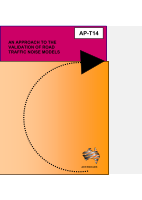Environment

An Approach to the Validation of Road Traffic Noise Models
- Publication no: AP-T14-02
- ISBN: 0 85588 605 6
- Published: 1 January 2002
- PDF (free) Download
This document has been prepared by Austroads as a guide to the preparation and assessment of validation studies of traffic noise prediction models, and represents the final outcome of a project with the following key objectives: - the development of a technical basis for a preferred traffic noise model for use in Australia and New Zealand; - the development of a preferred road traffic noise modelling validation methodology; and - the development of guidelines for undertaking, reporting and assessing traffic noise validation studies. Any organisation wishing to assess the accuracy of a traffic noise prediction model could make use of this document in developing the study methodology, reporting the results of the study and assessing the acceptability of the study results. One aim of the project is to provide the technical basis for a consistent approach to traffic noise modelling within a framework of choice by authorities and users. The emphasis of this document, however, is to provide guidance in the preparation and assessment of road traffic noise validation studies. This report provides a summary of the current accuracy of state, territory and New Zealand noise models and examines the benefits of a common model to measure road traffic noise that may be applied nationally, with recommendations for uniform practices.
- 1. Introduction
- 1.1. About this project
- 1.2. Terminology
- 1.3. Road traffic noise modelling
- 1.3.1. Overview
- 1.3.2. A brief review of some methods
- 1.3.3. Validation of traffic noise models
- 1.4. A national approach to road traffic noise modelling
- 1.4.1. Austroads Strategic Plan
- 1.4.2. Arguments for and against a preferred traffic noise prediction method
- 1.4.3. Moves toward harmonisation in Europe
- 2. Validation studies - a discussion
- 2.1. Design of validation studies
- 2.1.1. The aims of the study
- 2.1.2. How to express accuracy
- 2.1.3. Calibration of noise models
- 2.2. Risk analysis
- 2.2.1. Risk in the use of traffic noise prediction models
- 2.2.2. Acceptable levels of risk
- 2.2.3. Calculation of calibration factors
- 2.2.4. Safety factors
- 2.2.5. Cost considerations
- 2.3. Recent validation studies
- 2.3.1. Overview
- 2.3.2. Methodologies
- 2.3.3. The ARRB study
- 2.3.4. The VicRoads traffic noise study
- 2.3.5. The Queensland Department of Main Roads traffic noise study
- 2.3.6. The New South Wales Roads & Traffic Authority study
- 2.3.7. The Transfund New Zealand study
- 3. Guidelines for undertaking a validation study
- 3.1. Introduction
- 3.1.1. Overview of the guidelines
- 3.1.2. Overview of the recommended methodology
- 3.2. Determination of the aims and methodology
- 3.2.1. Aims
- 3.2.2. Methodology
- 3.3. Site selection
- 3.3.1. Determination of the number of measurement sites required
- 3.3.2. Selecting sites
- 3.4. Measurements
- 3.4.1. Quantities to be measured
- 3.4.2. Measurement accuracy
- 3.4.3. Filtering of the measurements
- 3.5. Noise predictions
- 3.6. Comparison of the measured and predicted noise levels
- 3.7. Data review
- 3.7.1. Preliminary data review
- 3.7.2. Fitting the prediction differences to a normal distribution
- 3.7.3. Correlations between site parameters
- 3.7.4. Correlations between site parameters and prediction differences
- 3.7.5. Can the data be treated as a single population?
- 3.8. Determination of the mean and standard deviation
- 3.9. Calibration
- 4. Guidelines for reporting a validation study
- 4.1. Introduction
- 4.2. Preferred report structure
- 5. Guidelines for assessing a validation study
- 5.1. Introduction
- 5.2. Reliability of the study outcomes
- 5.3. Acceptability of the calculation method
- 6. Validation of software packages
- 6.1. Introduction
- 6.2. Current situation overseas
- 6.3. Assessment of software conformance
- References
- Appendix A: Issues
- Appendix B: Acoustic Terminology
- Appendix C: The VicRoads study
Related publications
WEB-R695-G104-2-23
Latest Environment News
